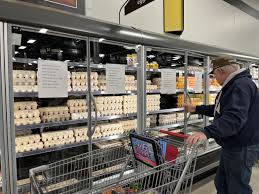Kentucky residents are facing rising egg prices as the state, along with the rest of the nation, grapples with the consequences of a severe bird flu outbreak. For the average consumer, a dozen eggs now costs more than $4, creating both a financial strain and a scramble to find enough eggs to meet demand. The surge in prices and reduced availability of eggs is tied to multiple factors, with the most significant being the avian flu (bird flu) that has decimated millions of egg-laying hens. Here’s a deeper look at the situation and the ongoing effects on both consumers and businesses.
The Impact of Bird Flu on Kentucky’s Egg Supply
Bird flu, particularly the highly pathogenic avian influenza (HPAI), has taken a heavy toll on the egg industry across the United States, including Kentucky. The disease spreads rapidly among poultry populations, causing the deaths of millions of birds. Egg-laying hens, which are essential to the supply of fresh eggs, have been particularly vulnerable to the virus. As of early 2025, the USDA reported that more than 50 million chickens and turkeys have been affected across the country, leading to an unprecedented shortage in egg production.
In Kentucky, the crisis has caused a noticeable uptick in prices. Steve McClain, the director of communications and public affairs at the Kentucky Retail Federation, noted that while the shortage was expected, it is still a challenge to handle. The USDA had already forecast that egg prices would likely rise in 2025, but the extent of the price jump has caught many off guard.
The shortage has impacted not just the price of eggs but also the ability to consistently find eggs in stores. Consumers have reported going to grocery stores only to find shelves either empty or stocked with limited quantities. The issue is compounded by panic buying, where customers buy in bulk out of fear of the shortage, making the supply chain even more strained.
Price Increases and Consumer Impact
The rise in egg prices has been felt across the board. As of early February 2025, the average price for a dozen eggs in Kentucky has surpassed $4, with prices fluctuating depending on the store and location. This marks a significant jump from the pre-crisis price of around $2 to $2.50 per dozen. The ripple effect of these price hikes is being seen in nearly every part of daily life.
For example, many restaurants, particularly fast-food chains and diners that rely heavily on eggs in their meals, have been forced to adjust their pricing to cope with the increased costs. Waffle House, a well-known restaurant chain, made the decision to implement a temporary surcharge of 50 cents per egg on its menu, citing the steep rise in egg prices. Instead of raising prices across the board, Waffle House chose to target the surcharge directly to items that rely on eggs. The surcharge is expected to last as long as the egg price hike continues, but restaurant officials have made it clear that they hope the shortage is temporary.
For consumers, the impact is felt most in their grocery bills. As egg prices soar, households are forced to rethink their purchasing habits, with some shoppers limiting their egg purchases to reduce costs. For those with families, the increase in egg prices can result in a higher weekly grocery bill, particularly for those who rely on eggs for breakfast or cooking.
Panic Buying and Supply Chain Challenges
In addition to the bird flu outbreak, panic buying has played a major role in exacerbating the egg shortage. In recent years, we’ve seen consumers rush to stock up on certain goods during times of crisis, such as during the COVID-19 pandemic. In the case of eggs, this behavior has created spikes in demand that the supply chain simply cannot keep up with. As stores experience higher-than-normal traffic for egg purchases, shelves empty out quickly, and it becomes harder for suppliers to restock.
McClain explained that panic buying stretches the supply chain and creates difficulties for both suppliers and stores in getting eggs back on shelves. The ripple effect of panic buying can linger long after the initial wave of purchases, making recovery a slow process. Even as the egg shortage starts to ease, the disruptions caused by panic buying have lingering effects on the market.
As a result, McClain and other experts are advising consumers to be mindful of their egg purchases. Overbuying not only strains the supply chain but also limits access for others in need. Shoppers are encouraged to buy what they reasonably expect to consume in the short term, rather than stockpiling, to ensure more equitable distribution of eggs.
How Kentucky Consumers Are Adjusting
In response to the higher prices and limited availability of eggs, consumers are making adjustments. Some are turning to egg substitutes for cooking, using alternatives like powdered eggs or plant-based egg products. These alternatives are often more affordable and can provide a temporary solution for those feeling the pinch of rising prices.
Additionally, some consumers are seeking eggs from local farms or farmers’ markets, where prices might still be more stable. However, these alternatives are not always as accessible, especially in urban areas where large grocery stores dominate the market.
Some people are also reevaluating how they use eggs in their meals, with families looking for ways to stretch their egg purchases further. Instead of using eggs in every meal, consumers might opt for recipes that require fewer eggs or substitute eggs with other ingredients.
Despite these adjustments, the reality is that many consumers are simply feeling the strain. For some, the increased cost of eggs means choosing between eggs and other essential food items. While eggs are a staple of the American diet, the rising cost of eggs could force families to rethink their meal planning and eating habits.
What’s Next for the Egg Shortage?
Looking ahead, the question remains: How long will this egg shortage last? While there are no definitive answers, experts suggest that egg prices may remain elevated until the bird flu crisis subsides and the supply chain stabilizes. In the meantime, consumers and businesses will likely continue to feel the pressure.
The USDA and other agricultural agencies are working to address the spread of bird flu and prevent further outbreaks. There are also efforts to bolster egg production in areas that were less impacted by the disease, though recovery may take time. Once the flu is under control, the supply of eggs should gradually improve, helping to alleviate some of the pressure on the market.
For businesses like Waffle House and other restaurants, the continued uncertainty about egg prices and availability means that they must keep a close eye on the situation. Many are hopeful that the shortage is a temporary issue, but until then, they will continue to adjust their pricing models and menu options to cope with the rising costs.
Conclusion
The egg shortage in Kentucky, driven by the bird flu crisis and compounded by panic buying, is affecting consumers, businesses, and the agricultural supply chain. Prices have reached record highs, and finding eggs in stores has become increasingly difficult. While the situation is challenging, experts urge consumers to be mindful of their purchases and avoid overbuying, which only exacerbates the problem.
As the bird flu outbreak continues to disrupt egg production, it is unclear when the shortage will end. However, it is hoped that once the flu is contained and the supply chain recovers, egg prices will stabilize. Until then, both businesses and consumers will need to find ways to adapt to this ongoing crisis, with many looking to alternatives and adjusting their consumption habits to manage the higher costs.
Disclaimer – Our editorial team has thoroughly fact-checked this article to ensure its accuracy and eliminate any potential misinformation. We are dedicated to upholding the highest standards of integrity in our content.





More Stories
Waffle House Tackles Egg Shortage with Temporary Surcharge as Prices Continue to Climb
Waffle House Tackles Egg Shortage with Temporary Surcharge as Prices Continue to Climb
Waffle House Tackles Egg Shortage with Temporary Surcharge as Prices Continue to Climb